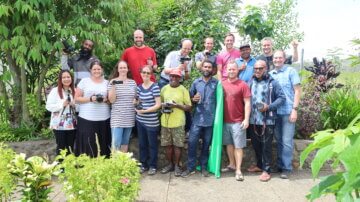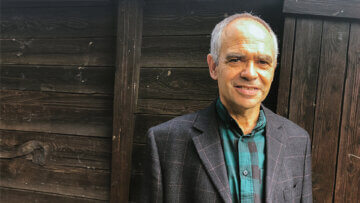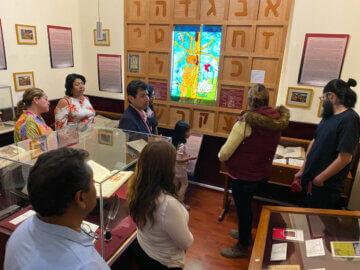A Conversation with Rob Myers of DOOR International
Rob Myers, President of DOOR International, spoke with us about the status of sign language Bible translation in 2020.
Here is our conversation.

Rob Myers, President of DOOR International
Can you give a quick summary of what DOOR does, especially in relation to Bible translation?
Our organisation started officially in 1999, and our focus was training indigenous Deaf leaders in evangelism and church planting. Over the next five years we trained about 350 deaf leaders from about 50 different countries, using a chronological Bible storying method. It’s consistent with oral storytelling and some of the current approaches that are out there.
We then received a grant to do some follow-up, to see how these leaders were doing in the field. They would come for one year of training and then go back out and begin to plant fellowships in Deaf churches and evangelise. We saw that wherever the person who was trained went, they had a thriving fellowship around them. But that couldn’t multiply. We dug a little deeper and realised that a main reason was that these communities didn’t have Scripture in their heart language. We would train these leaders in storying, so over the course of the year they would memorise the stories, but then they went back to these fellowships and they were, in one sense, the Bible for these people. So you had this telephone-game issue, where they were trying to pass the information on to others, but they were far from the source who was teaching them. At some point they didn’t have anything to reference, really.
Going deeper into Bible translation for deaf communities is a lot bigger challenge than for hearing communities, right?
When we talk about sign language Scripture and why it’s necessary, one of the big struggles that people have typically is assumptions that hearing people have. Deaf people can see, therefore, there is an assumption they can read well. Therefore, why don’t we just give them written Scripture? If they struggle with a language, just simplify it. Simple English, simple Spanish or something like that.
How do you help people understand written Scripture is not the solution for most Deaf people?
Through my interactions with other Deaf people I came to realise how much written language is sound-based. Hearing people learn a language by hearing it and then copying it and speaking it. That’s how we become fluent in this spoken language. Then we go to school and learn a phonetic way to sound out letters connected to a language we already know. But for Deaf people who have missed all of that information — 90 percent of deaf people grow up without being able to communicate with their parents — they get into school and they’re trying to sound these letters out and it is not connected to a language they know.
Deaf people can learn to read, and I know a lot of Deaf people who are fluent in reading English. But it’s not their first language. This is why Deaf people need Scripture in their heart language. Many, many Deaf people worldwide struggle with written language.
How did DOOR respond to this challenge?
We partnered in 2006 and 2007 with Wycliffe and SIL, and received some training from them in Bible translation. They commissioned our first three translation consultants in sign language. Starting from that point, we began with two translations, and that has blossomed so that we’ve been involved in about 20 different translation projects. We currently are actively involved in 10 of them.

Sigh language ministry work in Ghana.
How does the process begin?
We work primarily with Deaf communities that start with almost no Christian presence — which is true for the vast majority of Deaf communities. We start by bringing in Deaf missionaries from another country, maybe nearby. They begin to do evangelism and church planting work, so that there is a large leadership population of Christians who then can be recruited to begin to do translation work. (The missionaries) will do some translation work and work with that team for about two project periods, or about six years. We get them some initial Scripture, get them up and running, and then try to see if we can transfer that connection. Either they form their own local Christian association or they get connected to their national Bible Society, or a particular denomination — something more local so that the work can be sustained. And then we route those resources — consultants and other things — toward other projects.
So a lot of our focus is really initial Scripture access, initial training of some of these teams.
We have been late as a movement to recognise that Deaf communities are kind of the last frontier in Bible translation, right?
Right. There are about 350 sign languages, a little more than that worldwide. There’s still a lack of clarity when it comes to how many of those languages need Bible access, because some are fairly small and maybe dying out.
Around 30 sign languages have some published Scripture right now. Some portion. So that is less than 10 percent of the sign languages out there. It represents about 31 percent of the Deaf people.
 For all the progress that’s been made in not leaving Deaf communities behind the last few years, does it feel like COVID places all of that at risk?
For all the progress that’s been made in not leaving Deaf communities behind the last few years, does it feel like COVID places all of that at risk?
There are a couple things I would say to that. The first is, the interesting shift of everyone going to Zoom. Most Deaf organisations have been on Zoom for years. So this was just more of the same.
The one interesting thing that did happen for most Deaf communities, when COVID first hit, was a lack of access to information. Bible translation is one symptom of the general lack of information access. We were getting reports from multiple countries where deaf people had never been told about the stay-at-home orders, so they left their homes as they normally did. They came to a city and noticed things were closed. Policeman found them and started yelling at them for not being at home. They didn’t understand, and they got beaten to a point where they had to be hospitalised. Unfortunately, that was a fairly common story among some countries.
We use that illustration as symptomatic of the lack of information access that Deaf people typically have.
Most of the translations that DOOR has been involved in, we were able to make most of the shift online. We also have several translation centers. In some of the translations that we work with, teams are actually located on the centers. So when we closed and sequestered the centers, they could continue to do their work, even when visitors were limited in their ability to come in.
What impact have international travel restrictions had on sign language translation, then?
The translation consulting we do is pretty highly specialised. Most hearing translation consulting happens from resources within the country. If, for example, in Kenya, BTL is doing a translation with a hearing group, there are other hearing consultants in Kenya, so as long as people can travel within Kenya, then translation consulting can continue to take place with these teams. But because there are so few sign language translation consultants, usually you are taking somebody from one country and bringing them into another for two weeks to do checking with the team. And that’s obviously all come to a halt.
Is there a remote option for that?
That really varies depending on the community. We’ve seen some situations where that works pretty well. The time zone issues are not always that great, but it still works pretty well. We’ve also seen situations where the internet access is just bad enough that you just can’t even have a consistent video conversation with a team.
The longer-term impact that we’re going to see — and Stephen Coertze mentioned this when he was giving his video speech to Global Alliance leaders — is that relationships are going to be much more challenging in this kind of virtual environment. Especially in Global South communities. Because a country may not have experience in sign languages, internationals need to come in and help the community set up a translation project. But that involves building relationships with both hearing and Deaf nationals in those countries. Right now, we don’t have a good solution for that. Really developing a trust relationship that’s necessary to get involved in deep partnership requires face-to-face interaction. That’s a really difficult scenario right now.
That’s not hitting us right now, but I look into the future and think, unless things improve, that’s going to stall, especially in the formation of new projects.
Given the progress that has been made the last few years, are you sensing any frustration around that?
I think the frustration is probably more at the ends of the organisations that are involved in starting new translations. I think the translations that are going right now are experiencing some hiccups, but are figuring out ways around that.
Every Tribe Every Nation’s ultimate goal is to see all people access Scripture by 2033. On the sign language side, we have to start a number of translations each year to meet that goal. Will that happen? That’s a big question mark given some of the delays that are happening in terms of new project starts.
What does the recent completion of the American Sign Language Video Bible mean overall for Deaf translation?
There are two separate American Sign Language translation projects that both completed at the same time. One was Deaf Missions’ 39-year project. They are the longest running sign language translation project out there. That was a huge accomplishment, just to finally get one sign language that has complete access to Scripture. Since American Sign Language is the most recognised sign language on the internet, a lot of Deaf people worldwide are learning some American Sign Language. There are a lot of resources in ASL. So there was a push to finish that, in part because that would then help serve as a source text to give more information to Deaf communities that are otherwise completely cut off.
Sign languages, just like spoken languages, have varying relationships with one another. Some are closer to ASL and some are very, very different. The hope is that this serves as one of several resources.
The other project that also finished, Deaf Harbor, was working in partnership with us to complete 110 chronological Bible narrative passages. These are the key passages that Deaf communities have identified, saying, “If we need key Scripture to do evangelism and discipleship in church planting, this is a foundational Bible that we need access to, to be able to give tools to people who are working in the field, and then move further into full, book-by-book translation.” That also completed at the end of September. And that will also serve as a next resource for other sign languages that will be producing that kind of chronological Bible translation.
Especially with that longer project, the one that took 39 years, the technology and processes are completely different from when they started, right?
Yes, they started with VHS tapes. Everything that you would imagine. Editing is totally different today.
What are some technological advances on the near horizon?
There is technology being worked on by a number of different organisations with the hope that we can bring sign language translation even closer to where spoken and written language translations are. For instance, you can search for words in spoken and written language translations. You can’t search for a sign. But it looks like in the next year or so, we may have that possibility.
And then, features like find and replace. In a sign language translation today, if somebody makes a mistake in a three-minute passage that they have memorised, they have to go back and sign the whole three-minute passage again. You can’t clip out that one sign and clip in another sign in the way that you could with a word processor. That’s one of the things that causes sign language translation to be longer and more expensive.
There is also experimentation happening using avatars in the videos instead of actual people, right? What is the thinking behind that?
I couldn’t tell you who translated the ESV, even though I use the ESV a lot. I mean, their names are in the front of the Bible and if I wanted to find it I could. But I don’t know a lot of their backgrounds. Deaf communities are small. When there is a signed, visual translation — the translator is right there on the screen. And if they suddenly declare that they are not believers anymore, or their life doesn’t match what they are signing, then that can cause some of that Scripture to not even be usable in the community. Avatars could deal with some of those issues, so we don’t have to throw out whole passages of Scripture because of the person involved.
What do you wish the rest of the Bible translation movement knew about sign language translation?
The lack of access to resources that are presumed in a spoken-language context. It’s hard for some people to realise what’s involved in trying to get a sign language translation team up and running. As an example, one of the classic hearing approaches to translation is to take source material in a language of wider communication. If we translate resources in that language, most people who use spoken language know a trade language plus their mother tongue. And then they can use those resources, which some have pretty good access to, to do translation. But if you go to the sign language side and think about the reading issue that goes on with most Deaf communities, then all of those trade languages and all of those resources are kind of out the window. They are not usable for Deaf communities. So if you take all the information you have from hearing it and reading it and throw all of that out the window, then how are we going to train this translation team? That’s a significant issue.
One of the other things that is a big deal in the Deaf community ... there’s been a push for what we would call church-centric translation. There’s a big, big distinction between the situation of the church in Deaf communities and in hearing communities. Again, if the spoken language communities have all this access to resources, then you have people who have been to seminary. Even if they don’t have Scripture in their heart language, they have all of that training and background. But in most Deaf communities, less than 2 percent of people are believers. The existence of a church in these communities is very, very minimal. So there have been some pushes for church-centric translation to happen in these communities where there really isn’t a Deaf church in the first place. It’s created a lot of challenges.
The resources available now for sign languages are equivalent to what for hearing communities may have been available in the 1400s or 1500s. We have technology advances, but the resourcing information that’s available is still way behind where hearing communities are. That’s a tension that we constantly live in, to try to bring those resources up to speed.
How do we solve this?
We would all say that no one organisation can do this alone. That is very clear. And the Deaf Community can’t do it alone apart from the hearing community. It’s going to take learning techniques that have worked well in the hearing community that do apply in the Deaf Community, but also throwing out things that don’t work, even when they have worked in the hearing community.
Probably the biggest bottlenecks right now in sign language Bible translation are translation consultants, technology and funding. Those are the big three. If we can figure out how to solve those, then that can accelerate Bible translation moving forward.
Is there anything else you would like to say for the benefit of Global Alliance members?
For any Global Alliance organisations that find themselves beginning to recognise that sign languages are a need in their communities, organisations like SIL’s Global Sign Languages Team or DOOR would definitely welcome a conversation to talk about the best way to approach this.
We can help with questions like, what resources are available out there right now? What translations are happening nearby where a team in that specific country could interact with several other teams in order to get a sense of what would be involved and how to get something started.
Contact Rob Myers at robm@doorinternational.org.
Story: Jim Killam
Alliance organisations may download the images from this story.
The latest
View all articles
Informing, teaching, inspiring: PNG workshop teaches video storytelling for language communities
PNG workshop teaches video storytelling for language communities
Read more
Looking ahead at 2024
As the year unfolds, we marvel at the work of God in our rapidly changing world. And, we look forward to a number of gatherings and conversations intended to draw us together.
Read more
Telling the Bible's Story
It may come as a surprise that a museum is among the Wycliffe Global Alliance organisations.
Read more